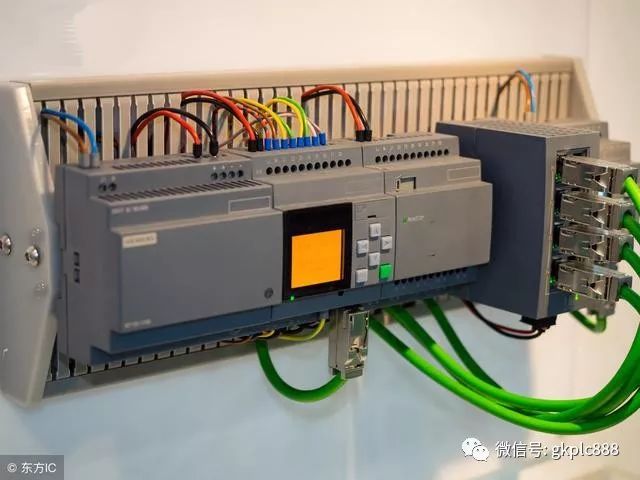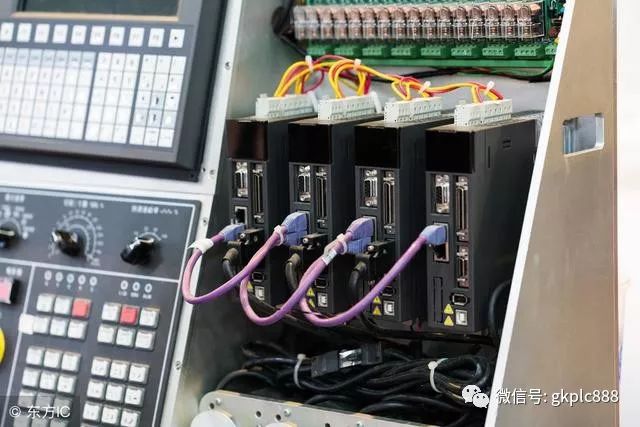Anyone engaged in electrical work knows that industrial production and technological development are inseparable from the automation control of PLCs. PLC can be broadly understood as a centralized relay extension control cabinet. In actual production applications, PLC greatly saves industrial control costs and strengthens centralized management and automatic control of equipment. To learn PLC well, a solid foundation in PLC is essential.
1. From the composition of PLC, besides CPU, memory, and communication interfaces, what other interfaces are directly related to the industrial site? Please explain their main functions.
(1) Input Interface: Accepts signals from controlled devices and drives the internal circuit to connect or disconnect through optocoupler devices and input circuits.
(2) Output Interface: The execution results of the program are output through the optocoupler devices and output components (relays, thyristors, transistors) of the output interface, controlling the connection or disconnection of external loads.
2. What are the basic components of a PLC? What are their functions?
(1) CPU: The core component of the PLC, directing the PLC to perform various tasks, such as accepting user programs and data, diagnostics, and executing programs;
(2) Memory: Stores the system and user programs and data;
(3) I/O Interface: The connecting component between the PLC and the controlled objects in the industrial production site, used to receive signals from controlled devices and output the execution results of the program;
(4) Communication Interface: Exchanges information with other devices such as monitors and printers through communication interfaces;

3. What types of PLC digital output interfaces are there? What are their characteristics?
Thyristor Output Type: Generally can only carry AC loads, fast response speed, high operating frequency;
Transistor Output Type: Generally can only carry DC loads, fast response speed, high operating frequency;
Relay Output Type: Generally can carry both AC and DC loads, but has a longer response time and lower operating frequency.
4. What types of PLC are there based on structural form? What are their characteristics?
(1) Integrated Type: Combines CPU, power supply, and I/O components in one chassis, compact structure, low cost, generally used for small PLCs;
(2) Modular Type: Divides the PLC into several separate modules, allowing for flexible configuration and easy expansion and maintenance, generally used for medium to large PLCs. Modular PLC consists of a frame or baseboard and various modules, with modules installed in the sockets of the frame or baseboard.
(3) Stacked Type: Combines the characteristics of both integrated and modular types, where the CPU, power supply, and I/O interfaces are independent modules connected by cables, making the system both flexible in configuration and compact in size.
5. What is the scanning cycle of a PLC? What mainly affects it?
The scanning process of a PLC includes five stages: internal processing, communication service, input processing, program execution, and output processing. The time required to scan through these five stages once is called the scanning cycle.
The scanning cycle is related to the CPU operating speed, PLC hardware configuration, and the length of the user program.

6. How does a PLC execute user programs? What stages does the execution process include?
A PLC executes user programs using a cyclic scanning method. The execution process of the user program includes the input sampling stage, program execution stage, and output refresh stage.
7. What advantages does a PLC control system have over a relay control system?
(1) Control Method: PLC uses programming to achieve control, making it easy to change or add control requirements, and PLC contacts are infinite;
(2) Operating Mode: PLC adopts a serial working mode, enhancing the system’s anti-interference capability;
(3) Control Speed: The contacts of a PLC are essentially triggers, with instruction execution time in the microsecond range;
(4) Timing and Counting: PLC uses semiconductor integrated circuits as timers, with clock pulses provided by a crystal oscillator, offering high delay accuracy and wide range. PLC has counting functions that relay systems do not possess;
(5) Reliability and Maintainability: PLC employs microelectronics technology, ensuring high reliability, and its self-checking function can promptly detect faults, while monitoring features facilitate debugging and maintenance.
8. Why does a PLC experience output response lag? How can I/O response speed be improved?
Because the PLC adopts a centralized sampling and centralized output cyclic scanning working method, the input status can only be read during the input sampling stage of each scanning cycle, while the execution results of the program are only sent out during the output refresh stage; additionally, delays in PLC input and output, as well as the length of the user program, can cause output response lag.
To improve I/O response speed, methods such as direct input sampling, output refreshing, interrupt I/O, and intelligent I/O interfaces can be employed.
9. What types of internal soft relays are there in the FX0N series PLC?
Input relays, output relays, auxiliary relays, status registers, timers, counters, data registers.

1) Model Selection: Consider structural form, installation method, functional requirements, response speed, reliability requirements, and model uniformity;
2) Capacity Selection: Consider I/O point count and user storage capacity;
3) I/O Module Selection: Includes the selection of digital and analog I/O modules, as well as special function modules;
4) Selection of power modules and programming devices, among other equipment.
11. Briefly describe the characteristics of the PLC centralized sampling and centralized output working method. What are the advantages and disadvantages of using this working method?
Centralized Sampling: In a scanning cycle, input state sampling only occurs during the input sampling stage. Once entering the program execution stage, the input ends will be locked.
Centralized Output: In a scanning cycle, the output image register’s states related to output are only transferred to the output latch during the output refresh stage for refreshing the output interface. In other stages, the output states remain in the output image register. This working method can enhance the system’s anti-interference capability and reliability but may lead to output response lag.
12. What working method does a PLC adopt? What are its characteristics?
A PLC adopts a centralized sampling, centralized output, cyclic scanning working method.
Characteristics: Centralized sampling means that during a scanning cycle, the PLC samples input states only during the input sampling stage, and the input ends will be locked once entering the program execution stage.
Centralized output means that during a scanning cycle, the PLC only transfers states related to output from the output image register to the output latch during the output refresh stage, refreshing the output interface; in other stages, the output states remain in the output image register.
Cyclic scanning means that a PLC needs to perform multiple operations within a scanning cycle, executing them sequentially in a time-sharing manner, repeatedly running.
13. What are the main components of an electromagnetic contactor? Briefly describe its working principle.
An electromagnetic contactor generally consists of an electromagnetic mechanism, contacts, an arc extinguishing device, a release spring mechanism, a bracket, and a base. The contactor operates based on electromagnetic principles: when the electromagnetic coil is energized, the coil current generates a magnetic field, attracting the armature and driving the contacts, causing normally closed contacts to open and normally open contacts to close, which are interlinked. When the coil is de-energized, the electromagnetic force disappears, and the armature falls under the action of the release spring, restoring the contacts, meaning that normally open contacts open and normally closed contacts close.
14. Briefly describe the definition of a Programmable Logic Controller (PLC).
A Programmable Logic Controller (PLC) is an electronic device designed for digital operation in industrial environments. It uses programmable memory to store instructions for executing logical operations, sequential operations, timing, counting, and arithmetic operations, and can control various types of machinery or production processes through digital or analog inputs and outputs.
PLCs and their related peripheral devices should be designed to easily form an integral part of industrial control systems and to facilitate the expansion of their functions.
15. Briefly explain the differences in working principles between PLC systems and relay contactor systems.
Different contact counts;
Different methods of implementing control;
Different operating modes.
16. Briefly explain the characteristics of the STL step ladder instructions of Mitsubishi FX2N series PLC.
(1) Source transfer automatic reset;
(3) Main control function.
Source: Industrial Robots
Disclaimer: If there are copyright issues regarding the videos, images, or text used in this article, please notify us immediately. We will confirm the copyright based on the evidence you provide and pay remuneration according to national standards or delete the content immediately! 010-88379790 ext. 811




